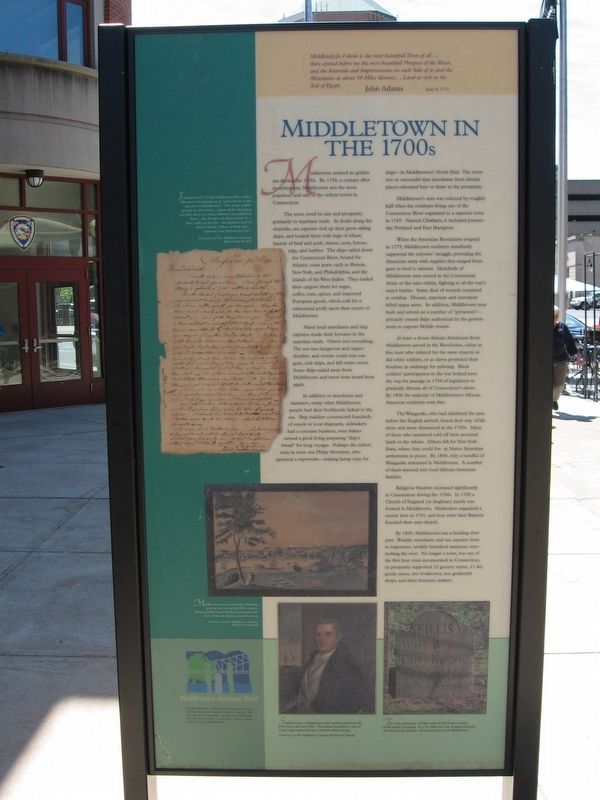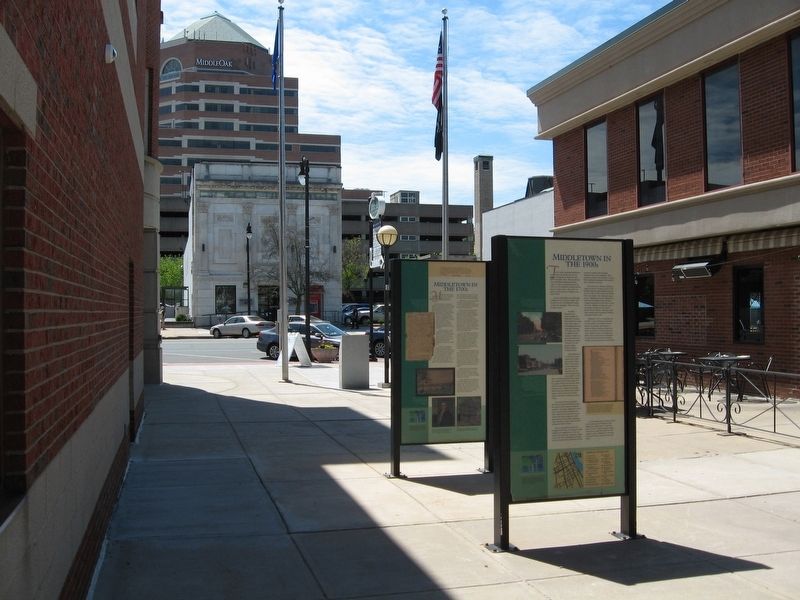Middletown in Middlesex County, Connecticut — The American Northeast (New England)
Middletown in the 1700s
Middletown entered its golden era during the 1700s. By 1750, a century after its settlement, Middletown was the most populous and one of the richest towns in Connecticut.
The town owed its size and prosperity primarily to maritime trade. At docks along the riverside, sea captains tied up their great sailing ships, and loaded them with bags of wheat barrels of beef and pork, cheese, corn horses, pigs, and lumber. The ships sailed down the Connecticut River bound for Atlantic coast ports such as Boston, New York, and Philadelphia and the islands of the West Indies They traded their cargoes there for sugar, coffee, rum, spices, and imported European goods, which sold for a substantial profit upon their return to Middletown.
Many local merchants and ship captains made their fortunes in the maritime trade. Others lost everything. The sea was dangerous and unpredictable, and storms could ruin cargoes, sink ships, and kill entire crews. Some ships sailed away from Middletown and never were heard from again.
In addition to merchants and mariners, many other Middletown people had their livelihoods linked to the sea. Ship builders constructed hundreds of vessels in local shipyards, sailmakers had a constant business, even bakers earned a good living preparing "ship's bread" for long voyages. Perhaps the richest man in town was Philip Mortimer, who operated a ropeworks – making hemp rope for ships – in Middletown's North End. The town was so successful that merchants from distant places relocated here to share in the prosperity.
Middletown's area was reduced by roughly half when the residents living east of the Connecticut River organized as a separate town in 1769. Named Chatham, it included present-day Portland and East Hampton.
When the American Revolution erupted in 1775, Middletown residents steadfastly supported the colonies' struggle, providing the American army with supplies that ranged from guns to beef to mittens. Hundreds of Middletown men served in the Continental Army or the state militia, fighting in all the war's major battles. Some died of wounds sustained in combat. Disease, exposure and starvation killed many more. In addition, Middletown men built and served on a number of "privateers privately owned ships authorized by the government to capture British vessels.
At least a dozen African Americans from Middletown served in the Revolution, either as free men who enlisted for the same reasons as did white soldiers, or as slaves promised their freedom in exchange for enlisting. Black soldiers' participation in the war helped pave the way for passage in 1784 of legislation to gradually liberate all of Connecticut's slaves. By 1800 the majority of Middletown's African American residents were free.
The Wangunks, who had inhabited the area before the English arrived, found their way of life more and more threatened in the 1700s. Man of those who remained sold off their ancestral lands to the whites. Others left for New York State, where they could live in Native American settlements in peace. By 1800, only a handful of Wangunks remained in Middletown. A number of them married into local African-American families.
Religious freedom increased significantly in Connecticut during the 1700s. In 1750 a Church of England (or Anglican) parish was formed in Middletown. Methodists organized a society here in 1791, and four years later Baptists founded their own church.
By 1800, Middletown was a bustling river port. Wealthy merchants and sea captains lived in impressive, lavishly furnished mansions overlooking the river. No longer a town, but one of the first four cities incorporated in Connecticut, its prosperity supported 22 grocery stores, 11 dry goods stores, two bookstores, two goldsmith shops, and three furniture makers.
In January of 1779, Revolutionary War soldier Ebenezer Frothingham, Jr. wrote home to his parents in Middletown: “The Army suffers greatly for Provision. Some of the Brigades are four days at a time without a mouthful of Meat, the Troops are almost starv’d. They suffered greatly, the greatest part of them without a Shoe to their feet. I intreat your Prayers for me.”
Middletown was an attractive, thriving port at the end of the 18th century, when resident Anne Watkinson painted this view of the city from across the river.
- Courtesy of the Middlesex County Historical Society
Stephen Clay, a Middletown ship captain, posed for his portrait in the late 1700s. The painter included a view of Clay’s ship under full sail, a symbol of his success.
- Courtesy of the Middlesex County Historical Society
The 1760 gravestone of Fillis, wife of Cuff Negro, stands in Riverside Cemetery. In 1750, Fillis was one of approximate 200 African Americans – all of them slaves – in Middletown.
Erected by the Middlesex County Historical Society.
Topics. This historical marker is listed in these topic lists: Colonial Era • Settlements & Settlers.
Location. 41° 33.609′ N, 72° 38.944′ W. Marker is in Middletown, Connecticut, in Middlesex County. Marker is at the intersection of Main Street and Court Street, on the right when traveling north on Main Street. Touch for map. Marker is at or near this postal address: 100 Main Street, Middletown CT 06457, United States of America. Touch for directions.
Other nearby markers. At least 8 other markers are within walking distance of this marker. Middletown in the 1600s (here, next to this marker); Middletown in the 1800s (here, next to this marker); Middletown in the 1900s (here, next to this marker); Bigelow Tavern (a few steps from this marker); Middletown and the Connecticut River (about 600 feet away, measured in a direct line); Old City Hall Bell (about 700 feet away); Russell Library (approx. 0.2 miles away); The UNESCO Slave Route Project (approx. 0.2 miles away). Touch for a list and map of all markers in Middletown.
More about this marker. Weather has affected the clarity of the text and pictures. The Middlesex County Historical Society generously aided in transcribing this marker.
Credits. This page was last revised on November 13, 2020. It was originally submitted on October 10, 2016, by Michael Herrick of Southbury, Connecticut. This page has been viewed 487 times since then and 36 times this year. Photos: 1, 2. submitted on October 10, 2016, by Michael Herrick of Southbury, Connecticut.

